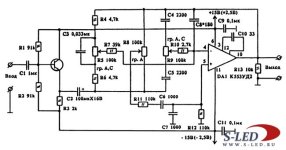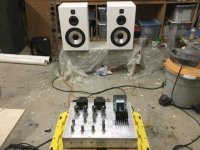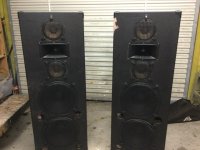That one is more of a “3 band EQ”. Without getting into calculations on your gyrators, what kind of Q did you target? Center freq on the bass?
if you do a search, you will see that i like to refer people to the tone control design in old APT preamp schematic. It adds a unity gain buffer to eliminate the interaction normally seen in the Baxandall tone control scheme. the comments about limiting the active range should be seriously considered; i wouldn't have more than +/- 6 to 8dB MAX boost/cut range at whatever turnover frequencies you choose. good luck!
If you start cranking up the bass for example the bass will clip long before upper frequencies.Because they often suck the life out of the sound.
The trend of removing all tone controls is the wrong way to go. In room frequency response is king. Changin speakers to change the in room response is a very expensive way to adjusting frequency response.
Go DSP, to get full control of frequency response.
Even more useful was the Loudness control of yesterday, matching up to the human ears natural loudness curve.
Unfortunately not easy to make work well when you do not have a physical potentiometer as volume control though (in DSP) 😉
Go DSP, to get full control of frequency response.
Even more useful was the Loudness control of yesterday, matching up to the human ears natural loudness curve.
Unfortunately not easy to make work well when you do not have a physical potentiometer as volume control though (in DSP) 😉
My peeve with “loudness” controls is that they were never calibrated right. There was always a HOT source (typically FM) that ended up boosting bass some 20 dB more than any other source. The solution to that was a MIXER for a preamp but only DJs tended to have those, and S/N was typically 20 dB worse than a high end preamp. Baxandall controls were more useful because you could dial the boost in. One didn’t need to build them with 1KHz turnover frequency either. Increase those bass control cap values by a factor of 5 and it sounds MUCH better.
Baldwin yes wrong way but not when its in contrast to a badly designed eq. Like the ones where a veil disappear and or music gets much louder when tone defeat is pressed.
Cheers
Cheers
I had bought some high end Yamaha preamp at a yard sale. The tone controls were made of resistive material deposited on a glass substrate. The reason why they were getting rid of it was because it got dropped on one of the tone knobs, cracking that glass and that one was ruined.Like the ones where a veil disappear and or music gets much louder when tone defeat is pressed.
Not an easy component to source a replacement for...
In investigating the problem, I believe I saw the schematic. That tone control circuit was designed such that with the controls at the center detent, the signal went through as a direct mechanical connection. You could see the extra terminal on that potentiometer and the spot where the wiper made physical contact.
No 'tone defeat' necessary! Yamaha really worked to get that to happen, fabricating their own custom control pots.
I did a search on apt tone controls and found several posts. One that I found was my own from 2009: https://www.diyaudio.com/community/threads/aspen-headphone-amp.152031/post-1951062@mlloyd1 Who was APT?
Cheers!
APT was the company name. Their preamp and power amp were legenadary performers, especially for their time. They got great reviews. And they wrote the BEST user manuals ever created, even to this day. Find the preamp manual pdf and read it.
The bass is centered at about 80-90 hz!That one is more of a “3 band EQ”. Without getting into calculations on your gyrators, what kind of Q did you target? Center freq on the bass?
I plan to show(with acoustic measurements) all 3 Q's and their bandwidths along with max cut/boost. The mid has a wide bandwidth!
The amplifier I'm currently working on has a switchable tone control, which is made according to a different from Baxandall circuit.
The tone control circuit was simulated in RFSim99, assembled and fully verified. The adjustment range is from -6dB to +10dB. I think this is enough for a small correction. Unlike other types of tone controls, the circuit I used does not introduce any distortion at zero positions of the controls.
https://www.diyaudio.com/community/...fet-design-in-class-a-a-b.404961/post-7497775
The tone control circuit was simulated in RFSim99, assembled and fully verified. The adjustment range is from -6dB to +10dB. I think this is enough for a small correction. Unlike other types of tone controls, the circuit I used does not introduce any distortion at zero positions of the controls.
https://www.diyaudio.com/community/...fet-design-in-class-a-a-b.404961/post-7497775
I try to have most of the audiopath to select equipment with as flat as possible frequency curve and lowest distorsion. Only then I have to select the loudspeaker with the sound of my taste. For me no tonecontrol and balance. The less adjustments the more time to joy the music.
But I also started with deq2496 and dcx2496, great stuff to play with.
But I also started with deq2496 and dcx2496, great stuff to play with.
I believe I've listened to a Luxman that only had dials for turnover frequencies - None for amount of eq. That would keep people from messing excessively.
Cheers!
Cheers!
”Large” speakers require no tone controls. One’s definition of “large“ also varies. The amp for the little one has a Baxandall circuit. Some wives might say even they are too big. They could be stuck with the others - which need no tone control because they usually get played a little higher on the Fletcher-Munson curves.I try to have most of the audiopath to select equipment with as flat as possible frequency curve and lowest distorsion. Only then I have to select the loudspeaker with the sound of my taste. For me no tonecontrol and balance. The less adjustments the more time to joy the music.
But I also started with deq2496 and dcx2496, great stuff to play with.
Attachments
- Home
- Amplifiers
- Solid State
- Bass, Treble, Balance


